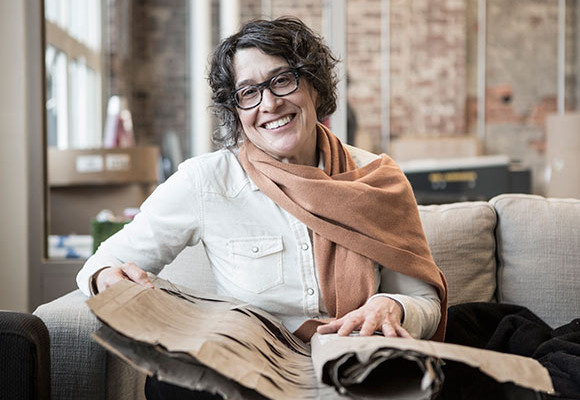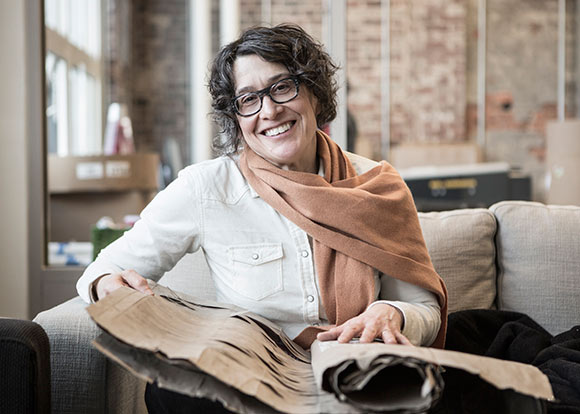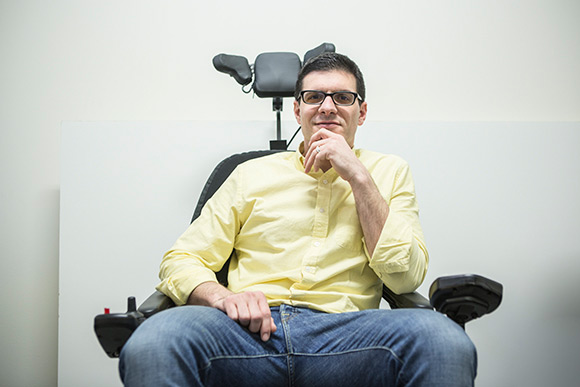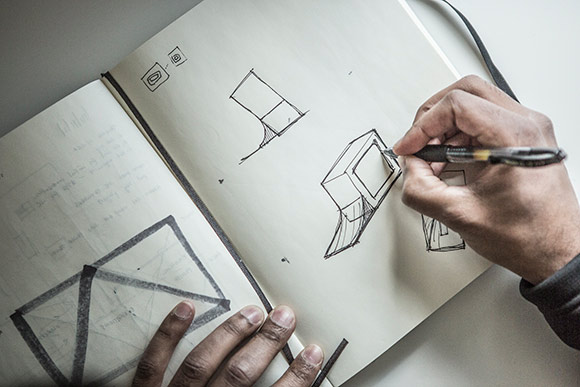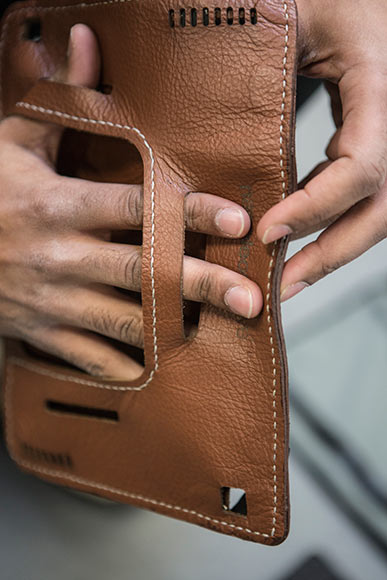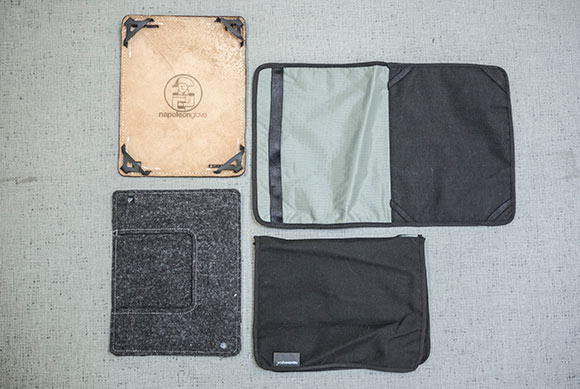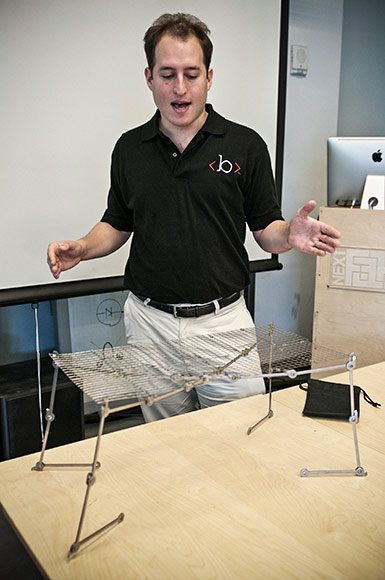Want to make something cool? In this city, you’re not the only one.
NextFab Studio has been around for barely three years and in that short span Philly’s “gym for innovators” outgrew its original space at the University City Science Center. The membership-based, high-tech workshop and prototyping center’s new home –21,000 square feet on Washington Avenue — officially opened in January. The beefed-up facility is both a boon for local artists and small-scale manufacturers, and a tremendous boost to a struggling commercial corridor.
Walking into the new NextFab, it’s easy to be seduced by all the state-of-the-art equipment. In addition to SolidWorks, a Computer Assisted Design (CAD) software that renders true-to-life modeling, NextFab provides access to industrial textile machines, a water jet cutter, a CNC plasma cutter and a high definition 3-D printer the height of a small person. These are fabrication machines that typically don’t exist outside academic and factory settings.
But the real story behind NextFab is not what they have but who they attract. With its deep industrial roots, Philly has long boasted a creative community that loves using their hands — urban gardeners, craft brewers, crafters, hackers and salvage masters help define the city’s character.
So what happens when this spirit of tactile innovation meets the tools of high-tech fabrication? Flying Kite went behind the scenes to find out.
The Artist
Shelly Spector was altering prints on Photoshop 20 years ago, long before it was considered art. But when 3-D printers and laser cutters from companies like Lotus Laser came along, she assumed they were intended for factories. That changed once she got her hands on a digital sewing machine.
“I’m a little geeky anyways,” she admits. “I didn’t really have anything in mind, but I saw it as a way to increase what I could do.”
Spector was formally trained in sculpture at University of the Arts and already had serious cred when she joined NextFab in the spring of 2011. The former Breadboard artist-in-residence has received grants from the Pennsylvania Council on the Arts and the Independence Foundation; her work is featured in the collections of Philadelphia Art Museum, Pennsylvania Academy of Fine Arts (PAFA) and the Human Rights Campaign in Washington, D.C.
Spector works big. Her most recent installation, “But Not As Much As Tomorrow” at Bridgette Mayer Gallery in Center City, included brick façade cut from old clothes, wallpaper made from cereal boxes and an entire room filled with handmade wooden spools. For productions this size, SolidWorks, laser cutting and digital embroidery are a no-brainer. Spector’s new challenge — which she meets by hand-drawing shapes before uploading them — is learning to be less precise.
“It’s really easy to use these tools to make something look polished,” she says. “The challenge for me is to use them to make something look handmade.”
The Designer
The inspiration for LollyGig’s first product, the NapoleonGlove, came to Laate Olukotun while watching Steve Jobs introduce the iPad in 2010.
“He was holding it double-handed in a way that made me feel like he was going to drop it on stage,” recalls Olukotun. “I was thinking, this thing is gonna get dropped by a lot of people.”
Once Olukotun confirmed that many people — including reps at the Apple Store and NYC subway riders — were struggling to hold onto their tablets, he started sketching solutions. The final design was a case that fit snuggly over a user’s hand, allowing a secure vertical or horizontal view.
“It’s essentially a handle but it’s just on the inside,” he says. “It seemed like there were so many other ways to go other than Apple’s single solution. It took me down this rabbit hole where I had to learn to sew, where I had to learn to use software.”
A self-described “LEGO kid,” Olukotun grew up hooked on Popular Science magazine. He studied architecture and economics at Yale, then worked on design concepts for Museum of Science & Industry and Mayo Clinic before gaining a masters in design from the Illinois Institute of Technology in 2006. In 2010, he left a job with Steelcase to start LollyGig.
The glove has many incarnations including felted wool, leather and 12-layer nylon with corner protectors printed in santoprene, a high-quality rubber. NextFab provides the tools to manipulate those materials.
LollyGig is currently developing iPhone 4 and iPhone 5 accessories and investigating scalable manufacturing. An early fan of GPS-enabled sports watches, Olukotun looks forward to making “smarter” products that incorporate hardware into everyday objects.
The Engineer
A quick chat with Tom Panzarella is a window into the very-near, semi-automated future. Within minutes, the founder of NextFab resident company Love Park Robotics references Google’s self-driving cars, vacuums that don’t need handles and golf courses tended by legions of robotic landscapers.
CoPilot, Love Park’s flagship software, enables robotic mid-sized vehicles (think golf carts and forklifts) to forgo mechanical controls and respond directly to human command. The company is currently working with a large wheelchair manufacturer. Rather than negotiate every table and chair, the user indicates general direction and the software guides the vehicle around obstructions.
“Typically, robotics systems are like an on/off switch with driving,” explains Panzarella. “We’ve layered our software in a way that it can put a human in the loop.”
The technology melds into the wheelchair’s existing design via hand-built hardware — using a blank circuit board and a solder machine — attached with 3-D-printed cases.
With advancing technology (and additional headgear) CoPilot could enable “brain controlled” devices — vehicles that operate on thoughts or eyeblinking. Panzarella says he’s also interested bringing telapresence (the technology behind video conferencing) to automatons, which users can operate through the internet.
“As a kid, I loved cars,” says Panzarella. “Now I’m building machines that think for themselves and see for themselves and have human-like capabilities. Focusing that on a socially beneficial area is double fold for me.”
The Inventor
Ben Ashpole, a grad student in Computer and Information Science at Penn, was vacationing in a state park outside Allentown when he ran into the classic camper’s dilemma: How do I cook?
The provided grill looked grubby so he built an apparatus from sticks and stones. That failed.
Determined to solve his culinary dilemma, Ashpole enrolled in the Wharton Venture Program and partnered with Penn Mechanical Engineering student Jay Olman. Shortly after, NextFab opened and Bashpole Inventions launched with a stainless steel prototype for the Pocket Grill.
“We wanted to make something that, when it was folded up, was small enough to fit in your pocket, but when you took it out was large enough to cook for multiple people,” says Olman.
The ultra-portable grill boasts an assembly time of less than one minute. It folds up to six-by-four inches and unfolds into a two-by-one foot surface that holds up to ten pounds. At full height, Pocket Grill is 15 inches tall (it can be shortened for heat adjustment). It also comes with a recipe book.
Bashpole Inventions used a CNC plasma cutter to create identical brackets for the prototype. The legs are attached at slight angles to strengthen the holding capacity.
After receiving significant viral exposure in 2012, the Pocket Grill was featured on Discovery.com, Gizmodo and Wired Magazine‘s Gadget Lab. They have been sold globally to consumers in the Netherlands, Columbia, Brazil, Mexico and on a U.S. army base in Italy.
The team has since launched Bashpole Cards, die-cut business cards that transform into game pieces for micro-sports such as paper football, soccer, hockey and basketball.
The Enabler
As an operating room nurse at Jefferson Hospital, Bob Sponsler is familiar with trauma. A patient is delivered — sometimes helicoptered — to the medical unit, bloodied and unable to respond. The room fills with medical staff and loved ones. It can take up to twenty minutes, or longer, for surgery to begin.
At this critical juncture, Sponsler has one goal: get the right instruments into the surgeon’s hand immediately. His only tool is a rolled up towel.
“I couldn’t get my instruments out of the tray and into the hand of the surgeons quickly enough,” he says. “Most of the time [the instruments] would fall over or get tangled up.”
So, in 2010, Sponsler decided to make his own organizing tool. Soon, other hospital employees were approaching him with ideas for retractors, clamps and other basic instruments. These inquiries sparked Rising Tide Innovations, a prototyping and consulting firm for simple medical devices, founded by Sponsler with two surgeons, Jay Jenoff and Mathew Rosen.
Currently, engineers build medical tools with minimal input from end users. A clinician with a good idea has two choices: sell it to a manufacturer or pay a hefty fee to have it developed. Rising Tide wants to change that broken system.
“We feel like we’re stepping into this at the dawn of an era where the end user can design and prototype their own device,” says Sponsler. “If you can draw something in CAD [Computer Assisted Design software], you can make it.”
Using advanced design software, 3-D printers and laser cutters, Rising Tide can turn a napkin sketch into a complex device, including moving parts, without making hardware. Their process for building and refining is modeled after Sponsler’s original process: Design a SolidWorks file, print it, use it, make adjustments and repeat.
“[My invention] was really just a chunk of plastic with slits in it,” he says. “I’d keep printing it until I got it just right.”
DANA HENRY is Flying Kite’s Innovation & Job News editor. Our partner for the “Inventing the Future” series is the University City Science Center.
Photographs at NextFab by MICHAEL PERSICO
Photographs of Jay Olman compliments of Jay Olman
